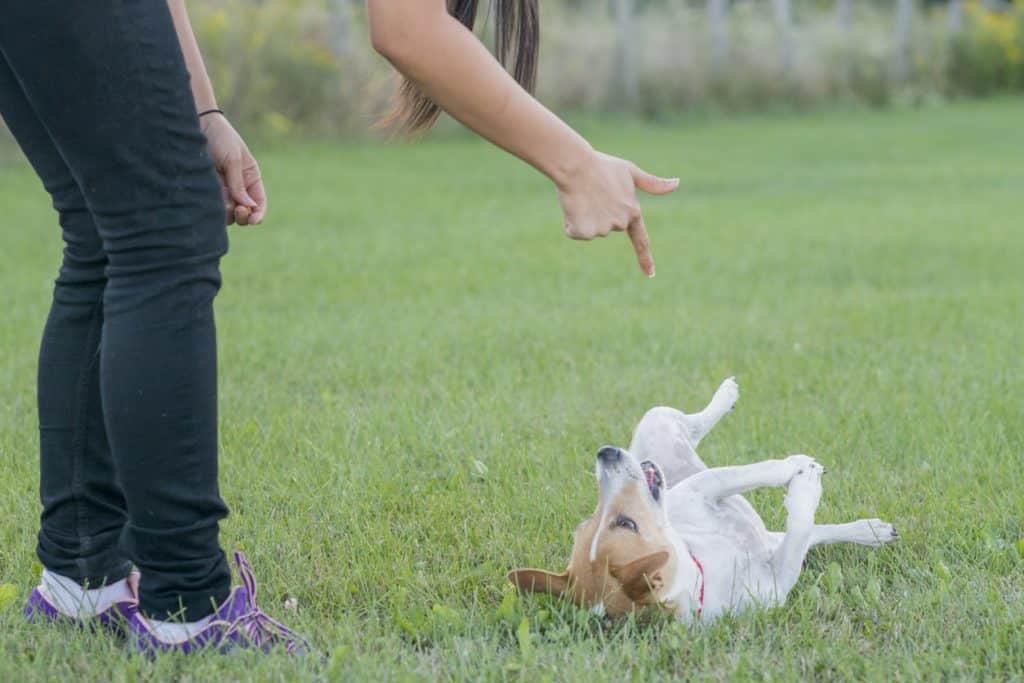- Not a substitute for professional veterinary help.
If you want to teach your dog a fun trick that starts with a “bang,” playing dead is perfect. Not only is this trick adorable, but regular training can also keep your dog’s brain sharp and help strengthen your bond.
Below, learn how to teach a dog to play dead step-by-step. Plus, discover troubleshooting tips from dog trainers and a vet.
What You’ll Need to Teach Your Dog to Play Dead
Before you start teaching your dog to “play dead,” it’s a good idea to have some training supplies ready. Here’s what you’ll need:
- A clicker. Clickers are small, handheld tools that make a sharp “click” sound. You use it when your dog does something right during training. When they do what you want, you click and give them a treat. The clicker helps your dog understand that the sound means they did a good job and are about to get a reward.
- A reward, like a tasty treat. Choose treats that smell strong, are easy to break into small pieces, and are a little moist, so they don’t make a mess. Nicole Ellis, Rover’s dog training expert, says these kinds of treats work best.
5 Steps to Teach Your Dog to Play Dead
With your training tools ready, you can begin teaching your dog to play dead with the following steps.
1. Teach “lie down”
“To teach a dog how to play dead, they first need to lie down on cue,” says Shoshi Parks, a certified professional dog trainer and owner of Modern Hound Dog Training in San Francisco.
If your dog doesn’t know this cue, check out our full guide to teaching your dog to lie down. Once your dog can lie down, move to the next step.
2. Lure your dog onto their side
“The next step is to encourage the roll action with a treat,” says Dwight Alleyne, a veterinarian with Better Pet. Start with your dog lying down. Then, hold a treat near their nose and slowly move it toward their opposite shoulder.
For example, Park says if they’re leaning on their left hip, move the treat over their right shoulder. This should help them roll onto their side.
3. Mark and repeat
When your dog follows your hand and starts to roll over, use the clicker and give them a treat. At first, reward them just for beginning to roll.
As they get better, only give the treat when they roll completely onto their side. Do this at least five times before moving on.
4. Introduce a hand gesture
Once your dog understands the action, you can add a hand signal.
Parks suggests using a “finger gun” gesture. Use the same motion with your hand as you did with the treat in steps 2 and 3. When your dog rolls over, click and give them a treat. Keep practicing until they’ve got it.
5. Add a verbal cue
After your dog understands the hand signal, you can add a word. Start by asking your dog to lie down.
“Say the word “‘Bang!’ (or an equally appropriate phrase) then point your hand ‘gun,’” Parks instructs. When your dog rolls over, click and reward them with a treat. Repeat until your dog has it down pat.
Why Should You Teach Your Dog to Play Dead?
Dr. Alleyne says that teaching your dog to play dead helps build trust and strengthens the bond between you and your dog.
Plus, training helps keep your dog’s attention sharp as they get older. Some studies even show that training dogs can improve people’s mental health, too. So, learning new tricks can be good for both you and your dog’s brains!
How Long Does It Take to Teach “Play Dead?”
Every dog breed is different, and some learn tricks faster than others. Dr. Alleyne says most dogs can learn to “play dead” in a few weeks if you practice regularly.

iStock/FatCamera
Teaching “Play Dead” Troubleshooting
If your dog is having trouble learning, try breaking the steps into smaller parts and practicing them one by one. It’s important to be patient, but don’t overwork your dog.
For example, a study with 44 beagles found that dogs trained once or twice a week learned faster than those trained every day. Shorter training sessions also worked better than long ones.
Finally, if your dog gets bored, you can try using a tastier treat. But if they seem frustrated, it’s okay to take a break!
Teaching “Play Dead” FAQs
What age can I teach my dog to play dead?
Ellis says you can teach any dog, from puppies to seniors, how to play dead.
In fact, researchers have found that aging doesn’t impact a dog’s selective attention, which allows dogs of any age to focus on clickers and treats during training.
What if my dog won’t stay on their side?
If your dog won’t stay on their side long enough, Dr. Alleyne suggests using the “stay” command. When your dog rolls over, say “stay,” then release them and give them a reward.
Learn how to master this cue in our guide to teaching your dog how to stay.
Is the “play dead” trick safe for dogs with joint problems?
Dogs with hip or joint pain may have a hard time lying down and getting up, which are key parts of playing dead. If your dog feels pain when lying down, this might not be the best trick for them.
What if my dog doesn’t respond to the verbal cue?
Some research shows that dogs might respond better to hand gestures than verbal commands.
Ellis says this is because dogs usually use body language to communicate. So, make sure your dog understands the hand signal before adding a word.
Can I teach a hyperactive dog to play dead?
Yes! It might take a little more effort, but training helps high-energy dogs stay focused, which can also prevent boredom.
Should I always use a clicker to teach my dog to play dead?
Many trainers like using clickers because they make it easy to mark the right behavior. However, research shows that clickers aren’t necessarily better than other rewards, so it depends on what your dog responds to best.
Are there dramatic elements I can add to the trick?
Yes! You could even teach your dog to cover their eyes with their paw after rolling over to make the trick extra dramatic.



